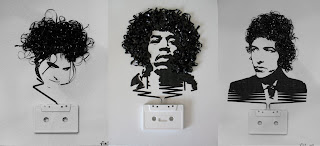The earliest recorded use of makeup involved the Egyptians of the 4th Century before Christ. Scented oils,
sheep fat based cremes and eye paint were applied by upper class women to beautify their facial features.
In the following millenniums, women in the Far East, especially the Japanese and Chinese, stained their faces with a
powder derived from rice to make their complexions a pasty white, while both men and women of the aristocratic classes in Europe applied
white lead and chalk powders to achieve the same ghostly effect. The pale face was desirable, as it differentiated the wealthy from the ‘common’ workers who had sun-bronzed complexions. Another method of obtaining the desired look involved a
powder comprised largely of hydroxide, carbonate, and lead oxide, the latter often leading to lead poisoning. During this same period, Greek women applied
ocher clay and
red iron to their lips – perhaps the first historical lipstick application.
Little changed during the dark centuries of the Middle Ages.
Perfumes with alcohol bases were introduced to Europe by Crusaders returning from the Middle East in the 1200’s. In the 1400’s upper class women in England, again seeking a whiter complexion, took to applying
egg whites to their faces. But the real emergence of makeup in European society took place commencing in the following two centuries, especially in France and Italy, with the former in particular being responsible for the development of manufacturing facilities for both makeup and perfumes. These were created from
aromatic natural ingredients like fruits, tree bark, flowers and roots employing a very laborious blending process that necessitated the use of excessive quantities of these
natural ingredients in order to produce very small amounts of products.
The use of cosmetics spread throughout Europe during the next two hundred years, with their use becoming more and more prevalent amongst all but the poorest women. And in the 1800’s, the French began developing more advanced scientific processes for the creation of new cosmetic products, with
zinc oxide bases now replacing more dangerous substances such as
copper and lead. And the first beauty salons made their appearance towards the end of the 19th century.
It should be noted that that at some times and places, such as in Victorian England of the 19th century, the use of makeup and other cosmetics was frowned upon and seen as proper only for stage actors and the like, being far too ‘vulgar’ for upper class society.
But the birth of the cosmetics industry as we know it today did not take place until the early 1930’s. In large part, Hollywood was responsible. Popular actresses such as Mary Pickford and Jean Harlow appeared on screen before millions of admiring women across America and Europe, introducing a modern tanned look to the masses. And Hollywood makeup artist Max Factor began using pancake make-up and other products to produce desirable looks for the cameras.
Following the end of the Second World War and with the emerging economic boom, came the growth of today’s cosmetics industry, accelerated by the new technology of television.
Ads for cosmetic products, especially lipsticks and mascaras, abounded and concurrently came the blossoming of the beauty magazine industry. Since the 1970’s an abundance of new cosmetic products to meet the concerns of a health conscious public have been created, such as
natural cremes and
conditioners and, more recently,
mineral makeup.
Today there are literally tens of thousands of cosmetic products on the market. Billboards, television, magazines, newspapers and the Internet are saturated with marketing messages for every possible sort of cosmetic need one can think of. For women, this means both more choice, and cheaper prices because of the amount of competition for the customer’s dollar. The cosmetics industry has definitely traveled a long way from the days of sheep fat cremes of the ancient world.



















































